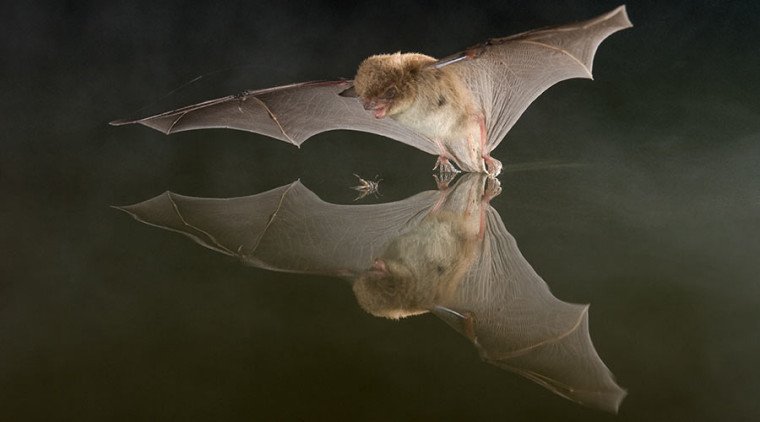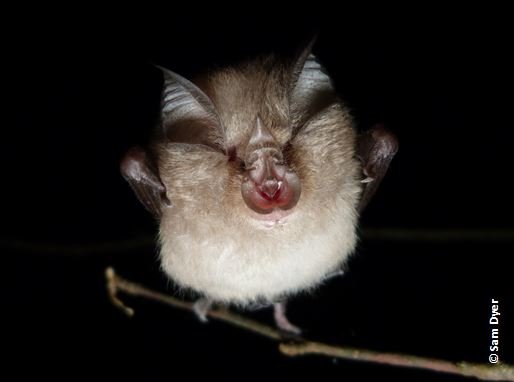Bats of Iveragh
When people think of our native mammals, they may picture a fox tiptoeing through a field, a stag roaring in the autumn rut or maybe hares boxing on a crisp spring morning. Our bats may often be overlooked, but as the only mammal capable of true flight, they are a wonderful group of animals that deserve their spot on the list of our favourite native mammals.
In Ireland, we have 9 resident bat species, all of which have been recorded on Iveragh: Lesser Horseshoe, Leisler’s, Daubenton’s, Brown Long-eared, Whiskered Bat, Natterer’s, and 3 Pipistrelle species - Common, Soprano and Nathusius’s. The Lesser Horseshoe Bat is in serious decline in many parts of their range on mainland Europe, but the species has a stronghold in the west of Ireland - including Iveragh. Therefore, our local habitats are internationally important for the survival of the species.
Daubenton’s Bat specialises in catching aquatic insects above the water surface. Look for them making regular passes along streams and rivers, twisting and turning to grab their prey mid-air. Image Paul van Hoof, Bat Conservation Ireland.
Our bats begin to appear in spring, emerging from their winter hibernacula – often a cave, hidden hollow in a tree or maybe a ruin of a forgotten farm building. Their pirouetting flights fill the air, especially around hedgerows, woodlands, and above waterways. Masters of aerial acrobatics, they pluck unlucky prey from mid-air or from the surface of leaves. A tiny pipistrelle bat weighing around 5g can eat up to 3,000 insects a night – great news for those of us who have suffered through a midge filled evening!
Mating occurs in autumn, but the females utilise a behaviour known as ‘delayed fertilization’. They can choose when to become pregnant and will wait for just the right conditions to do so in spring. When they feel a change in the weather and notice an increase in food, the females know it is the right time to give their pups the best chance of survival. These expectant mums gather in ‘maternity roosts’ – a safe haven for them and their new-born pups which arrive in June. As mammals, mums need to feed to produce milk for their hungry pup so they will venture out several times each night while knowing their little one is safe in the roost with the others. Each bat has a single pup, which they identify by scent on return to the roost. They rarely fly with them onboard.
Iveragh supports an internationally important population of Lesser Horseshoe Bat, which is in decline elsewhere. Image Sam Dyer.
Instead, the young bats socialise together, practicing their wing flapping and eventually taking little learning flight forays of their own. A recent study has even revealed that they ‘babble’, a type of early vocalisation that is the equivalent of human babies learning to speak – an important skill for any animals that live in groups. In late summer, our baby bats will leave the maternity roost and begin searching for food with the adults.
A common myth is that bats are blind, but they actually have quite good eyesight. Our bats regularly switch between visual hunting and echolocation when searching for food depending on habitat and light levels. Many bats sample the light levels in short flights around the entrance of their roost – this tells them whether it is safe to emerge and dark enough to avoid their many daytime predators. Artificial lighting can confuse bats during their light sampling flights and cause them to delay their emergence. This results in them missing the bounty of food which fills our air at dusk, a time when there is a cross over between day and night flying insects. This bounty is especially vital for those nursing mums with pups to feed. Artificial lighting also acts as a barrier to certain bat species because it makes them feel vulnerable to predators. It also has negative effects on bat prey species such as moths and their caterpillars, altering the food chain on which bats rely.
We are very fortunate to have bats in our environment and the establishment of the Kerry International Dark Sky Reserve can only help our furry flying friends. Bats are crucial links in our natural world, especially in their provision of a vital pest control service! They are also immersed in our deep-rooted fables and mythology – a clear indication that our ancestors were as intrigued by these secretive mammals as we are today. From bats getting stuck in our hair (likely a tall tale told to keep women indoors at night) to stories of shapeshifting and vampirism, their ability to conquer the night-time darkness - when we could not - has clearly influenced their position as shady characters in our folklore. But they are far more magnificent than malevolent, from their caring maternal nature to being the only mammal to take to the air. Our wonderful bats should surely take centre stage in our native wildlife line-up.
This map shows how the Lesser Horseshoe Bat has a stronghold in the west of Ireland, including Iveragh. Image from the Vincent Wildlife Trust.
Bat Bits
Did you know that different species of bat emit echolocation calls at different frequencies? This can also help you identify what species you have in your area. Gadgets such as a Batbox or an Eco Meter can be used to tune into these frequencies and your local bat calls. Maybe you even have a few species in your area when you presumed it was just the one!
The Irish name for a bat is ‘Ialtóg’ but they are also known as ‘Sciathán leathair’ which means ‘leather wing’. Their Latin order is known as ‘Chiroptera’ which means ‘winged hand’. They form their very own order (group) of mammals due to their ability of controlled flight.
A bat’s wings comprise of thin layers of skin known as a patagium. This membrane is stretched over the elongated finger bones of a bat’s hand which create the wings they use to fly.
Bats and Bugs is a collaboration between Bat Conservation Ireland and the National Parks and Wildlife Service. Their aim is to find out what our bats are eating, and you can help too. Have a look at the website for more info.
Bats are among a host of wildlife that have made their homes in our built landscapes. This Wildlife in Buildings booklet provides excellent information on what to do if you have bats in your home/restoration project and how to make your space more bat friendly. Don’t forget that they also live in trees.
Watch the Video
Further Information:
Bat Conservation Ireland - https://www.batconservationireland.org/
Vincent Wildlife Trust (build your own bat roost!) – https://www.vincentwildlife.ie/species/lesser-horseshoe-bat
Kerry International Dark Sky Reserve: https://www.kerrydarkskytourism.com/




